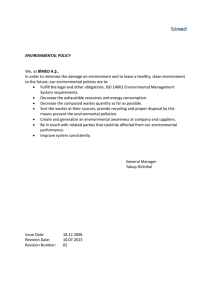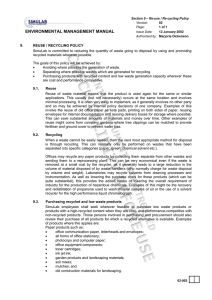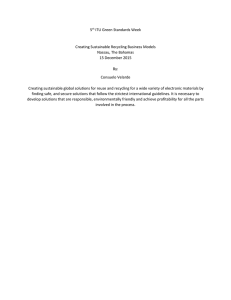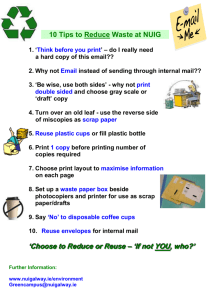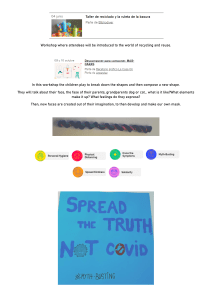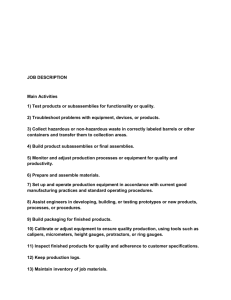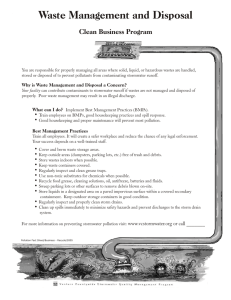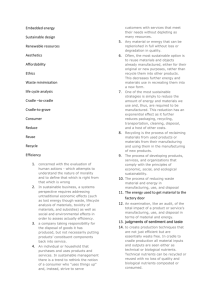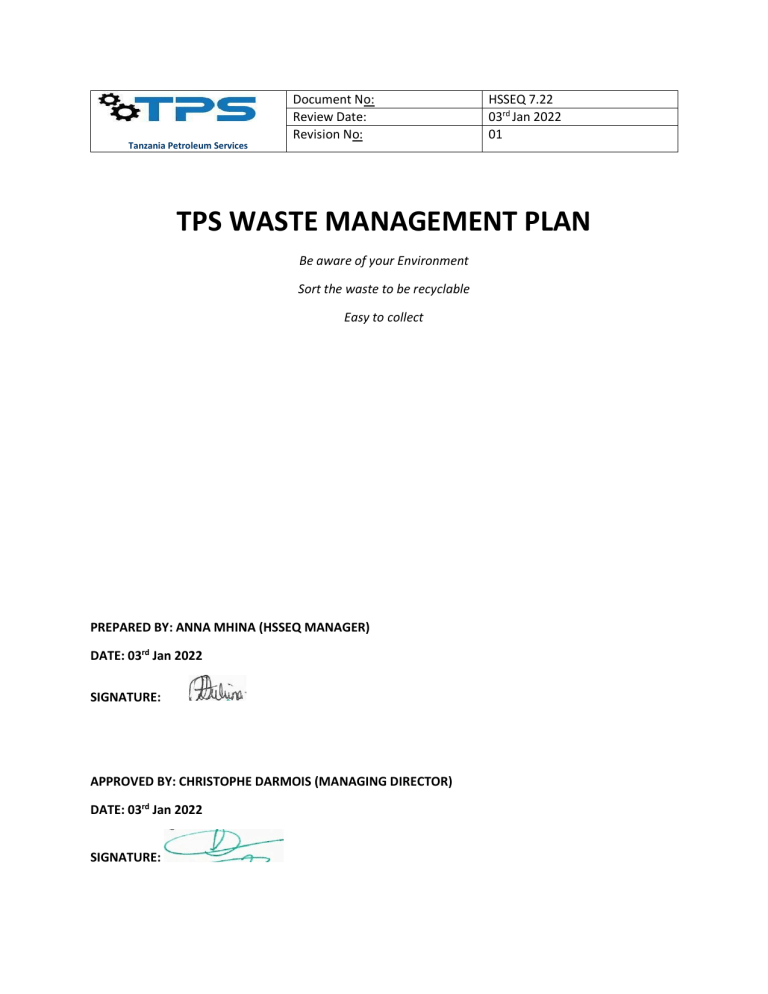
Tanzania Petroleum Services Document No: Review Date: Revision No: HSSEQ 7.22 03rd Jan 2022 01 TPS WASTE MANAGEMENT PLAN Be aware of your Environment Sort the waste to be recyclable Easy to collect PREPARED BY: ANNA MHINA (HSSEQ MANAGER) DATE: 03rd Jan 2022 SIGNATURE: APPROVED BY: CHRISTOPHE DARMOIS (MANAGING DIRECTOR) DATE: 03rd Jan 2022 SIGNATURE: 1. WASTE MANAGEMENT GOAL The Main waste management goal or objective is to recycle, reuse or salvage at least 75% by weight of the waste being generated. The recycling, reuse or salvage of the wastes is to be conducted at the waste management area. 2. WASTE PREVENTION MEASURES Designing of the waste management area, where recycling and general handling of the recyclable waste being generated on-site due to various activities will be conducted Reusable metal forms will be used at the fabrication workshop Providing signs and synergies to provide awareness on waste management as well as waste prevention measures. 3. REUSE AND SALVAGE ITEMS Timber remains will be used for other works or making items where necessary. 4. COMMUNICATION PLAN Waste prevention and recycling activities will be discussed at prestart job meeting/ toolbox talks All waste containers will be labelled in ENGLISH and SWAHILI languages 5. WASTE MANAGEMENT The management of TPS has a common practice that ‘All waste should reflect the Waste Management Hierarchy’, waste prevention and minimization being the first priority succeeded by reuse and recycling. 5.1 Prevention of waste The primary effort should be engaging in waste prevention and reduce the amount of waste generated in the first place i.e. use only the resources needed in a particular works. Prevention is financially advantageous as it reduces the purchase of surplus materials and obviates the need to remove wastes from site. It is important to emphasize the potential for certain purchasing procedures to contribute to a reduction of excessive materials wastage on site. EXAMPLES Ensuring materials are ordered on “as needed basis” to prevent over supply to sites Purchasing coverings, paneling or other materials in shape dimensions and form that minimizes the creation of excessive scrap waste on site Ensuring correct storage and handling of materials to minimize generation of damaged materials/waste e.g. keeping deliveries packaged until they are ready to be used Ensuring correct sequencing of operations; and Assigning individual responsibility (Through appropriate contractual arrangements) to contractors for the purchase of raw materials and for the management of wastes arising from their activities, thereby ensuring that available resources are not expended in an extravagant manner at the expense of TPS. Our design is based on Environmental friendly praxis and the necessary authorities have been involved and consulted in the process. 5.2 Reuse of waste Materials that are generated should be reused on-site or salvaged for subsequent reuse to the greatest extent possible and disposal should only be considered as a last resort. Initiatives should be put in place to maximize the efficient use/reuse of materials. 5.3 Recycling and disposal of waste There are number of established markets available for the beneficial use of waste, all materials will be sorted and stored in effective way on site and collected by our assigned waste management companies; 5.3.1 Waste Timber can be 5.3.2 Reused to make furniture for office use or household Sent for reprocessing as medium density fiberboard Waste Concrete Can be utilized as fill materials for roads or in the manufacture of new concrete when arising at source. 5.3.3 Cardboard, glass, plastic, paper common and Newspaper Will be collected by our assigned waste management company ‘LEMADE HAULERS LTD’ 5.3.4 Metal scrap, Aluminum scrap, waste oil and sludge Will be Collected by assigned company “NUSHIPPER ENTERPRISES CO. LIMITED”. 5.3.5 Used batteries Will be collected by assigned company “Fransis General Investment & Horse power Ltd” 5.3.6 General Domestic waste Will be collected by “LAMADE HAULERS LTD”. 5.4 Our Partners in the Waste Management: All Companies are registered Companies by the Vice President’s office and certified by National Environment Management Council (NEMC), we receive disposal or recycle notifications of each collected item. 6. HOW TO IMPLEMENT THE WASTE MANAGEMENT? 6.1 Overall Management of waste Waste Minimization, reuse and recycling need to be managed operationally be HSSEQ department to take responsibility for all aspects of waste management at different stages. 6.1.1 Step One-Plan and Prepare For TPS it is important that we started our WMP during the concept and designing of different projects. Design decisions can make a significant contribution to prevent and reduce waste in the first place. For example: Can you purchase materials with less or returnable packaging? Can you pre-order materials to specification? Planning these steps in advance makes us able to get the most out of our materials and helps us prevent them becoming waste. Figure 1: Waste Hierarchy 6.1.2 Step two –Allocate responsibility for the WMP Several departments (Projects & Engineering Operations, Procurements and HSSEQ) have been involved in the delivery of the plan, but the HSSEQ is appointed to take overall responsibility for the WMP. 6.1.3 Step Three-Identify your waste Identify the types of waste that will be produced and educate everybody on how to select and sort wastes. The early understanding and sorting makes the difference. 7. RECORD KEEPING We should have a system that ensures that details of all arising, movement and treatment of waste are recorded. All wastes delivered to waste management areas are recorded and all wastes dispatched are recorded. Security will only allow waste to be taken out with delivery note. All records to be kept at HSSEQ department. Records for generated wastes are summarized and reported to the necessary authorities every quarter of the year. 8. COLOR CODING WASTE SORTING Figure 2:waste sorting 9. COMPANY WASTES INVENTORY TYPE OF WASTE Papers & magazine Biodegradable waste: Food waste, green/leaves waste (excluding wood & big tree branches), papers (Cannot be recyclable and excluding boxes for packaging) Metal scraps Used PPEs (Dust masks, safety shoes, ear plugs, overall, aprons, gloves etc) Nylons, plastic bottles and polythene sheets Organic woods, big tree branches Food wastes Used Brushes and brooms Used cartridge Chemical containers and other plastic containers Metallic drums Pallets Hazardous waste: Glass materials, paints, chemicals, light bulbs, electrical appliances, fluorescent lamps, aerosol spray cans Welding rods dust and offcuts Fuel waste, used oils and grease, sludge Chemicals Tires, plastic pipes DISPOSAL PROCEDURE Reuse again to print internal documents, or collected and stored separately for recycling Kept at the large steel container and kept outside to compost and used at the garden or taken by municipal waste collectors These are sold to third parties for reuse or being reused at our fabrication workshop Kept at the store and segregated depending on the waste type and collectively disposed with other wastes Segregation done at the source and collectively disposed to municipal waste collectors Used as fire woods Used to feed animals (recycle) Collected according to their type for collective disposal Kept at the waste storage area for collective disposal Collected and kept in waste area for disposal or recycling depending on the nature of the chemical Sold to third part as scrap or alternative uses if available or reused to carry waste fuel Alternative uses such as fire wood or making furniture/items for office use Collected by authorized waste collector for burying at the designated area by government at Pugu dump site Collected by authorized waste collector for burying at the designated area by government Pugu dump site Contaminated fuel waste are filtered at waste area to separate water and fuel or collected by authorized hazardous waste collector for disposal at the incinerators or used as the energy source at the steel factories Collected (banding) and returned to supplier for recycle/reuse/disposal Stored and given to recyclers depending on the type of plastic for reuse (Bora factory) Sewages Batteries Electronic wastes 10. WASTE AREA DESIGN -Use of septic tanks, siphon using boozer and emptied to a central landfill site -Septic collected and siphoned with boozer then emptied to a municipal waste water treatment plants Collected by certified waste collector and disposed off at the factories for recycling Treated by the end product if plastic sorted as plastic, if not then treated as hazardous waste and given to hazardous waste collector
